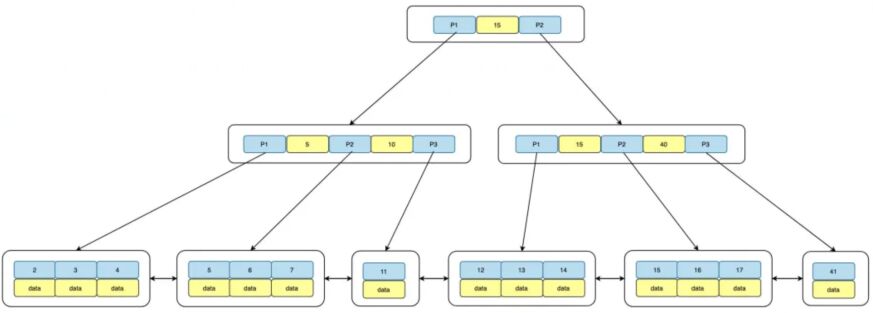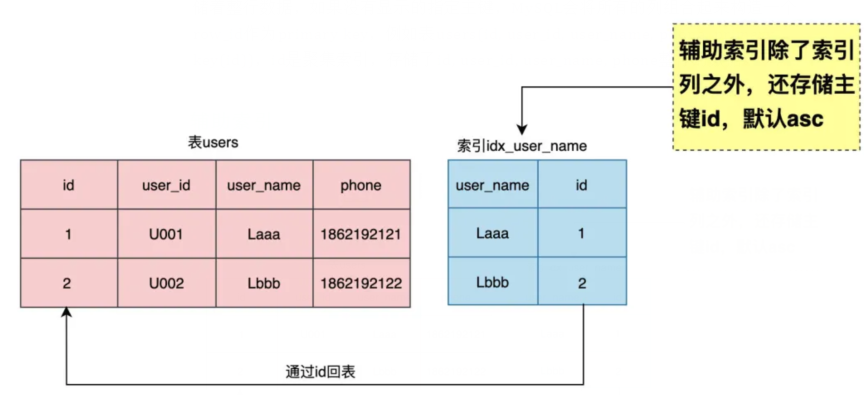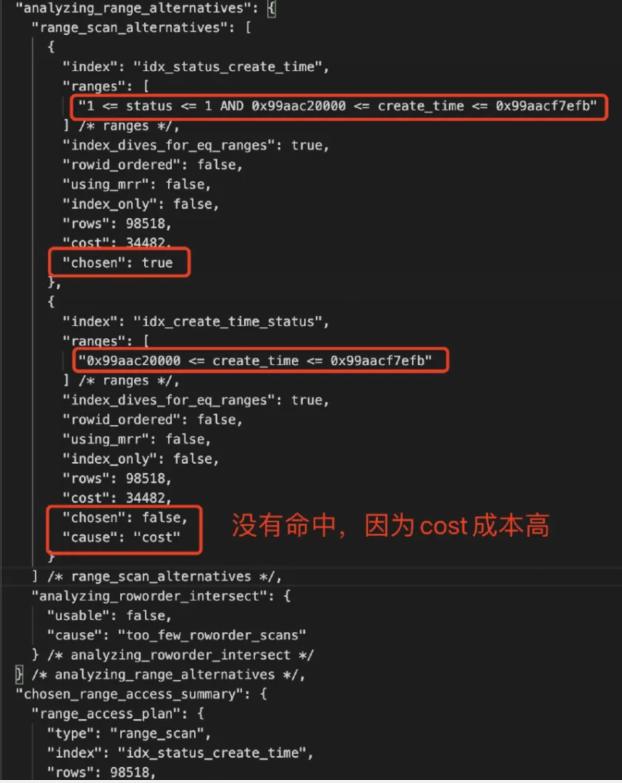Christina問(wèn)我:你都是如何設(shè)計(jì)索引的?
前言
數(shù)據(jù)庫(kù)系列更新到現(xiàn)在我想大家對(duì)所有的概念都已有個(gè)大概認(rèn)識(shí)了,這周我在看評(píng)論的時(shí)候我發(fā)現(xiàn)有個(gè)網(wǎng)友的提問(wèn)我覺(jué)得很有意思:帥丙如何設(shè)計(jì)一個(gè)索引?你們都是怎么設(shè)計(jì)索引的?怎么設(shè)計(jì)更高效?
我一想索引我寫(xiě)過(guò)很多了呀,沒(méi)道理讀者還不會(huì)啊,但是我一回頭看完,那確實(shí),我就寫(xiě)了索引的概念,優(yōu)劣勢(shì),沒(méi)提到怎么設(shè)計(jì),那這篇文章又這樣應(yīng)運(yùn)而生了。
本文
還是會(huì)有很多之前寫(xiě)過(guò)的重復(fù)概念,但是也是為了大家能更好的理解MySQL中幾種索引設(shè)計(jì)的原理。
正文我們知道,索引是一個(gè)基于鏈表實(shí)現(xiàn)的樹(shù)狀Tree結(jié)構(gòu),能夠快速的檢索數(shù)據(jù),目前幾乎所RDBMS數(shù)據(jù)庫(kù)都實(shí)現(xiàn)了索引特性,比如MySQL的B+Tree索引,MongoDB的BTree索引等。
在業(yè)務(wù)開(kāi)發(fā)過(guò)程中,索引設(shè)計(jì)高效與否決定了接口對(duì)應(yīng)SQL的執(zhí)行效率,高效的索引可以降低接口的Response Time,同時(shí)還可以降低成本,我們要現(xiàn)實(shí)的目標(biāo)是:索引設(shè)計(jì)->降低接口響應(yīng)時(shí)間->降低服務(wù)器配置->降低成本,最終要落實(shí)到成本上來(lái),因?yàn)槔习遄铌P(guān)心的是成本。
今天就跟大家聊聊MySQL中的索引以及如何設(shè)計(jì)索引,使用索引才能提降低接口的RT,提高用戶體檢。
MySQL中的索引
MySQL中的InnoDB引擎使用B+Tree結(jié)構(gòu)來(lái)存儲(chǔ)索引,可以盡量減少數(shù)據(jù)查詢時(shí)磁盤(pán)IO次數(shù),同時(shí)樹(shù)的高度直接影響了查詢的性能,一般樹(shù)的高度維持在 3~4 層。
B+Tree由三部分組成:根root、枝branch以及Leaf葉子,其中root和branch不存儲(chǔ)數(shù)據(jù),只存儲(chǔ)指針地址,數(shù)據(jù)全部存儲(chǔ)在Leaf Node,同時(shí)Leaf Node之間用雙向鏈表鏈接,結(jié)構(gòu)如下:

從上面可以看到,每個(gè)Leaf Node是三部分組成的,即前驅(qū)指針p_prev,數(shù)據(jù)data以及后繼指針p_next,同時(shí)數(shù)據(jù)data是有序的,默認(rèn)是升序ASC,分布在B+tree右邊的鍵值總是大于左邊的,同時(shí)從root到每個(gè)Leaf的距離是相等的,也就是訪問(wèn)任何一個(gè)Leaf Node需要的IO是一樣的,即索引樹(shù)的高度Level + 1次IO操作。
我們可以將MySQL中的索引可以看成一張小表,占用磁盤(pán)空間,創(chuàng)建索引的過(guò)程其實(shí)就是按照索引列排序的過(guò)程,先在sort_buffer_size進(jìn)行排序,如果排序的數(shù)據(jù)量大,sort_buffer_size容量不下,就需要通過(guò)臨時(shí)文件來(lái)排序,最重要的是通過(guò)索引可以避免排序操作(distinct,group by,order by)。
聚集索引
MySQL中的表是IOT(Index Organization Table,索引組織表),數(shù)據(jù)按照主鍵id順序存儲(chǔ)(邏輯上是連續(xù),物理上不連續(xù)),而且主鍵id是聚集索引(clustered index),存儲(chǔ)著整行數(shù)據(jù),如果沒(méi)有顯示的指定主鍵,MySQL會(huì)將所有的列組合起來(lái)構(gòu)造一個(gè)row_id作為primary key,例如表users(id, user_id, user_name, phone, primary key(id)),id是聚集索引,存儲(chǔ)了id, user_id, user_name, phone整行的數(shù)據(jù)。
輔助索引

輔助索引也稱為二級(jí)索引,索引中除了存儲(chǔ)索引列外,還存儲(chǔ)了主鍵id,對(duì)于user_name的索引idx_user_name(user_name)而言,其實(shí)等價(jià)于idx_user_name(user_name, id),MySQL會(huì)自動(dòng)在輔助索引的最后添加上主鍵id,熟悉Oracle數(shù)據(jù)庫(kù)的都知道,索引里除了索引列還存儲(chǔ)了row_id(代表數(shù)據(jù)的物理位置,由四部分組成:對(duì)象編號(hào)+數(shù)據(jù)文件號(hào)+數(shù)據(jù)塊號(hào)+數(shù)據(jù)行號(hào)),我們?cè)趧?chuàng)建輔助索引也可以顯示添加主鍵id。
- -- 創(chuàng)建user_name列上的索引
- mysql> create index idx_user_name on users(user_name);
- -- 顯示添加主鍵id創(chuàng)建索引
- mysql> create index idx_user_name_id on users(user_name,id);
- -- 對(duì)比兩個(gè)索引的統(tǒng)計(jì)數(shù)據(jù)
- mysql> select a.space as tbl_spaceid, a.table_id, a.name as table_name, row_format, space_type, b.index_id , b.name as index_name, n_fields, page_no, b.type as index_type from information_schema.INNODB_TABLES a left join information_schema.INNODB_INDEXES b on a.table_id =b.table_id where a.name = 'test/users';
- +-------------+----------+------------+------------+------------+----------+------------------+----------+------
- | tbl_spaceid | table_id | table_name | row_format | space_type | index_id | index_name | n_fields | page_no | index_type |
- +-------------+----------+------------+------------+------------+----------+------------------+----------+------
- | 518 | 1586 | test/users | Dynamic | Single | 1254 | PRIMARY | 9 | 4 | 3 |
- | 518 | 1586 | test/users | Dynamic | Single | 4003 | idx_user_name | 2 | 5 | 0 |
- | 518 | 1586 | test/users | Dynamic | Single | 4004 | idx_user_name_id | 2 | 45 | 0 |
- mysql> select index_name, last_update, stat_name, stat_value, stat_description from mysql.innodb_index_stats where index_name in ('idx_user_name','idx_user_name_id');
- +------------------+---------------------+--------------+------------+-----------------------------------+
- | index_name | last_update | stat_name | stat_value | stat_description |
- +------------------+---------------------+--------------+------------+-----------------------------------+
- | idx_user_name | 2021-01-02 17:14:48 | n_leaf_pages | 1358 | Number of leaf pages in the index |
- | idx_user_name | 2021-01-02 17:14:48 | size | 1572 | Number of pages in the index |
- | idx_user_name_id | 2021-01-02 17:14:48 | n_leaf_pages | 1358 | Number of leaf pages in the index |
- | idx_user_name_id | 2021-01-02 17:14:48 | size | 1572 | Number of pages in the index |
對(duì)比一下兩個(gè)索引的結(jié)果,n_fields表示索引中的列數(shù),n_leaf_pages表示索引中的葉子頁(yè)數(shù),size表示索引中的總頁(yè)數(shù),通過(guò)數(shù)據(jù)比對(duì)就可以看到,輔助索引中確實(shí)包含了主鍵id,也說(shuō)明了這兩個(gè)索引時(shí)完全一致。
索引回表
上面證明了輔助索引包含主鍵id,如果通過(guò)輔助索引列去過(guò)濾數(shù)據(jù)有可能需要回表,舉個(gè)例子:業(yè)務(wù)需要通過(guò)用戶名user_name去查詢用戶表users的信息,業(yè)務(wù)接口對(duì)應(yīng)的SQL:
- select user_id, user_name, phone from users where user_name = 'Laaa';
我們知道,對(duì)于索引idx_user_name而言,其實(shí)就是一個(gè)小表idx_user_name(user_name, id),如果只查詢索引中的列,只需要掃描索引就能獲取到所需數(shù)據(jù),是不需要回表的,如下SQL語(yǔ)句:
SQL 1: select id, user_name from users where user_name = 'Laaa';
SQL 2: select id from users where user_name = 'Laaa';
- mysql> explain select id, name from users where name = 'Laaa';
- +----+-------------+-------+------------+------+---------------+---------------+---------+-------+------+-------
- | id | select_type | table | partitions | type | possible_keys | key | key_len | ref | rows | filtered | Extra |
- +----+-------------+-------+------------+------+---------------+---------------+---------+-------+------+-------
- | 1 | SIMPLE | users | NULL | ref | idx_user_name | idx_user_name | 82 | const | 1 | 100.00 | Using index |
- mysql> explain select id from users where name = 'Laaa';
- +----+-------------+-------+------------+------+---------------+---------------+---------+-------+------+-------
- | id | select_type | table | partitions | type | possible_keys | key | key_len | ref | rows | filtered | Extra |
- +----+-------------+-------+------------+------+---------------+---------------+---------+-------+------+-------
- | 1 | SIMPLE | users | NULL | ref | idx_user_name | idx_user_name | 82 | const | 1 | 100.00 | Using index |
SQL 1和SQL 2的執(zhí)行計(jì)劃中的Extra=Using index 表示使用覆蓋索引掃描,不需要回表,再來(lái)看上面的業(yè)務(wù)SQL:
select user_id, user_name, phone from users where user_name = 'Laaa';
可以看到select后面的user_id,phone列不在索引idx_user_name中,就需要通過(guò)主鍵id進(jìn)行回表查找,MySQL內(nèi)部分如下兩個(gè)階段處理:
Section 1:select **id** from users where user_name = 'Laaa' //id = 100101
Section 2: select user_id, user_name, phone from users where id = 100101;
將Section 2的操作稱為回表,即通過(guò)輔助索引中的主鍵id去原表中查找數(shù)據(jù)。
索引高度
MySQL的索引時(shí)B+tree結(jié)構(gòu),即使表里有上億條數(shù)據(jù),索引的高度都不會(huì)很高,通常維持在3-4層左右,我來(lái)計(jì)算下索引idx_name的高度,從上面知道索引信息:index_id = 4003, page_no = 5,它的偏移量offset就是page_no x innodo_page_size + 64 = 81984,通過(guò)hexdump進(jìn)行查看
- $hexdump -s 81984 -n 10 /usr/local/var/mysql/test/users.ibd
- 0014040 00 02 00 00 00 00 00 00 0f a3
- 001404a
其中索引的PAGE_LEVEL為00,即idx_user_name索引高度為1,0f a3 代表索引編號(hào),轉(zhuǎn)換為十進(jìn)制是4003,正是index_id。
數(shù)據(jù)掃描方式
全表掃描
從左到右依次掃描整個(gè)B+Tree獲取數(shù)據(jù),掃描整個(gè)表數(shù)據(jù),IO開(kāi)銷大,速度慢,鎖等嚴(yán)重,影響MySQL的并發(fā)。
對(duì)于OLAP的業(yè)務(wù)場(chǎng)景,需要掃描返回大量數(shù)據(jù),這時(shí)候全表掃描的順序IO效率更高。
索引掃描
通常來(lái)講索引比表小,掃描的數(shù)據(jù)量小,消耗的IO少,執(zhí)行速度塊,幾乎沒(méi)有鎖等,能夠提高M(jìn)ySQL的并發(fā)。
對(duì)于OLTP系統(tǒng),希望所有的SQL都能命中合適的索引總是美好的。
主要區(qū)別就是掃描數(shù)據(jù)量大小以及IO的操作,全表掃描是順序IO,索引掃描是隨機(jī)IO,MySQL對(duì)此做了優(yōu)化,增加了change buffer特性來(lái)提高IO性能。
索引優(yōu)化案例
分頁(yè)查詢優(yōu)化
業(yè)務(wù)要根據(jù)時(shí)間范圍查詢交易記錄,接口原始的SQL如下:
- select * from trade_info where status = 0 and create_time >= '2020-10-01 00:00:00' and create_time <= '2020-10-07 23:59:59' order by id desc limit 102120, 20;
表trade_info上有索引idx_status_create_time(status,create_time),通過(guò)上面分析知道,等價(jià)于索引**(status,create_time,id)**,對(duì)于典型的分頁(yè)limit m, n來(lái)說(shuō),越往后翻頁(yè)越慢,也就是m越大會(huì)越慢,因?yàn)橐ㄎ籱位置需要掃描的數(shù)據(jù)越來(lái)越多,導(dǎo)致IO開(kāi)銷比較大,這里可以利用輔助索引的覆蓋掃描來(lái)進(jìn)行優(yōu)化,先獲取id,這一步就是索引覆蓋掃描,不需要回表,然后通過(guò)id跟原表trade_info進(jìn)行關(guān)聯(lián),改寫(xiě)后的SQL如下:
- select * from trade_info a ,
- (select id from trade_info where status = 0 and create_time >= '2020-10-01 00:00:00' and create_time <= '2020-10-07 23:59:59' order by id desc limit 102120, 20) as b //這一步走的是索引覆蓋掃描,不需要回表
- where a.id = b.id;
很多同學(xué)只知道這樣寫(xiě)效率高,但是未必知道為什么要這樣改寫(xiě),理解索引特性對(duì)編寫(xiě)高質(zhì)量的SQL尤為重要。
分而治之總是不錯(cuò)的
營(yíng)銷系統(tǒng)有一批過(guò)期的優(yōu)惠卷要失效,核心SQL如下:
- -- 需要更新的數(shù)據(jù)量500w
- update coupons set status = 1 where status =0 and create_time >= '2020-10-01 00:00:00' and create_time <= '2020-10-07 23:59:59';
在Oracle里更新500w數(shù)據(jù)是很快,因?yàn)榭梢岳枚鄠€(gè)cpu core去執(zhí)行,但是MySQL就需要注意了,一個(gè)SQL只能使用一個(gè)cpu core去處理,如果SQL很復(fù)雜或執(zhí)行很慢,就會(huì)阻塞后面的SQL請(qǐng)求,造成活動(dòng)連接數(shù)暴增,MySQL CPU 100%,相應(yīng)的接口Timeout,同時(shí)對(duì)于主從復(fù)制架構(gòu),而且做了業(yè)務(wù)讀寫(xiě)分離,更新500w數(shù)據(jù)需要5分鐘,Master上執(zhí)行了5分鐘,binlog傳到了slave也需要執(zhí)行5分鐘,那就是Slave延遲5分鐘,在這期間會(huì)造成業(yè)務(wù)臟數(shù)據(jù),比如重復(fù)下單等。
優(yōu)化思路:先獲取where條件中的最小id和最大id,然后分批次去更新,每個(gè)批次1000條,這樣既能快速完成更新,又能保證主從復(fù)制不會(huì)出現(xiàn)延遲。
優(yōu)化如下:
1.先獲取要更新的數(shù)據(jù)范圍內(nèi)的最小id和最大id(表沒(méi)有物理delete,所以id是連續(xù)的)
- mysql> explain select min(id) min_id, max(id) max_id from coupons where status =0 and create_time >= '2020-10-01 00:00:00' and create_time <= '2020-10-07 23:59:59';
- +----+-------------+-------+------------+-------+------------------------+------------------------+---------+---
- | id | select_type | table | partitions | type | possible_keys | key | key_len | ref | rows | filtered | Extra |
- +----+-------------+-------+------------+-------+------------------------+------------------------+---------+---
- | 1 | SIMPLE | users | NULL | range | idx_status_create_time | idx_status_create_time | 6 | NULL | 180300 | 100.00 | Using where; Using index |
Extra=Using where; Using index使用了索引idx_status_create_time,同時(shí)需要的數(shù)據(jù)都在索引中能找到,所以不需要回表查詢數(shù)據(jù)。
2.以每次1000條commit一次進(jìn)行循環(huán)update,主要代碼如下:
- current_id = min_id;
- for current_id < max_id do
- update coupons set status = 1 where id >=current_id and id <= current_id + 1000; //通過(guò)主鍵id更新1000條很快
- commit;
- current_id += 1000;
- done
這兩個(gè)案例告訴我們,要充分利用輔助索引包含主鍵id的特性,先通過(guò)索引獲取主鍵id走覆蓋索引掃描,不需要回表,然后再通過(guò)id去關(guān)聯(lián)操作是高效的,同時(shí)根據(jù)MySQL的特性使用分而治之的思想既能高效完成操作,又能避免主從復(fù)制延遲產(chǎn)生的業(yè)務(wù)數(shù)據(jù)混亂。
MySQL索引設(shè)計(jì)
熟悉了索引的特性之后,就可以在業(yè)務(wù)開(kāi)發(fā)過(guò)程中設(shè)計(jì)高質(zhì)量的索引,降低接口的響應(yīng)時(shí)間。
前綴索引
對(duì)于使用REDUNDANT或者COMPACT格式的InnoDB表,索引鍵前綴長(zhǎng)度限制為767字節(jié)。如果TEXT或VARCHAR列的列前綴索引超過(guò)191個(gè)字符,則可能會(huì)達(dá)到此限制,假定為utf8mb4字符集,每個(gè)字符最多4個(gè)字節(jié)。
可以通過(guò)設(shè)置參數(shù)innodb_large_prefix來(lái)開(kāi)啟或禁用索引前綴長(zhǎng)度的限制,即是設(shè)置為OFF,索引雖然可以創(chuàng)建成功,也會(huì)有一個(gè)警告,主要是因?yàn)閕ndex size會(huì)很大,效率大量的IO的操作,即使MySQL優(yōu)化器命中了該索引,效率也不會(huì)很高。
- -- 設(shè)置innodb_large_prefix=OFF禁用索引前綴限制,雖然可以創(chuàng)建成功,但是有警告。
- mysql> create index idx_nickname on users(nickname); // `nickname` varchar(255)
- Records: 0 Duplicates: 0 Warnings: 1
- mysql> show warnings;
- +---------+------+---------------------------------------------------------+
- | Level | Code | Message |
- +---------+------+---------------------------------------------------------+
- | Warning | 1071 | Specified key was too long; max key length is 767 bytes |
業(yè)務(wù)發(fā)展初期,為了快速實(shí)現(xiàn)功能,對(duì)一些數(shù)據(jù)表字段的長(zhǎng)度定義都比較寬松,比如用戶表users的昵稱nickname定義為varchar(128),而且有業(yè)務(wù)接口需要通過(guò)nickname查詢,系統(tǒng)運(yùn)行了一段時(shí)間之后,查詢users表最大的nickname長(zhǎng)度為30,這個(gè)時(shí)候就可以創(chuàng)建前綴索引來(lái)減小索引的長(zhǎng)度提升性能。
- -- `nickname` varchar(128) DEFAULT NULL定義的執(zhí)行計(jì)劃
- mysql> explain select * from users where nickname = 'Laaa';
- +----+-------------+-------+------------+------+---------------+--------------+---------+-------+------+--------
- | id | select_type | table | partitions | type | possible_keys | key | key_len | ref | rows | filtered | Extra |
- +----+-------------+-------+------------+------+---------------+--------------+---------+-------+------+--------
- | 1 | SIMPLE | users | NULL | ref | idx_nickname | idx_nickname | 515 | const | 1 | 100.00 | NULL |
key_len=515,由于表和列都是utf8mb4字符集,每個(gè)字符占4個(gè)字節(jié),變長(zhǎng)數(shù)據(jù)類型+2Bytes,允許NULL額外+1Bytes,即128 x 4 + 2 + 1 = 515Bytes。創(chuàng)建前綴索引,前綴長(zhǎng)度也可以不是當(dāng)前表的數(shù)據(jù)列最大值,應(yīng)該是區(qū)分度最高的那部分長(zhǎng)度,一般能達(dá)到90%以上即可,例如email字段存儲(chǔ)都是類似這樣的值xxxx@yyy.com,前綴索引的最大長(zhǎng)度可以是xxxx這部分的最大長(zhǎng)度即可。
- -- 創(chuàng)建前綴索引,前綴長(zhǎng)度為30
- mysql> create index idx_nickname_part on users(nickname(30));
- -- 查看執(zhí)行計(jì)劃
- mysql> explain select * from users where nickname = 'Laaa';
- +----+-------------+-------+------------+------+--------------------------------+-------------------+---------+-
- | id | select_type | table | partitions | type | possible_keys | key | key_len | ref | rows | filtered | Extra |
- +----+-------------+-------+------------+------+--------------------------------+-------------------+---------+-
- | 1 | SIMPLE | users | NULL | ref | idx_nickname_part,idx_nickname | idx_nickname_part | 123 | const | 1 | 100.00 | Using where |
可以看到優(yōu)化器選擇了前綴索引,索引長(zhǎng)度為123,即30 x 4 + 2 + 1 = 123 Bytes,大小不到原來(lái)的四分之。
前綴索引雖然可以減小索引的大小,但是不能消除排序。
- mysql> explain select gender,count(*) from users where nickname like 'User100%' group by nickname limit 10;
- +----+-------------+-------+------------+-------+--------------------------------+--------------+---------+-----
- | id | select_type | table | partitions | type | possible_keys | key | key_len | ref | rows | filtered | Extra |
- +----+-------------+-------+------------+-------+--------------------------------+--------------+---------+-----
- | 1 | SIMPLE | users | NULL | range | idx_nickname_part,idx_nickname | idx_nickname | 515 | NULL | 899 | 100.00 | Using index condition |
- --可以看到Extra= Using index condition表示使用了索引,但是需要回表查詢數(shù)據(jù),沒(méi)有發(fā)生排序操作。
- mysql> explain select gender,count(*) from users where nickname like 'User100%' group by nickname limit 10;
- +----+-------------+-------+------------+-------+-------------------+-------------------+---------+------+------
- | id | select_type | table | partitions | type | possible_keys | key | key_len | ref | rows | filtered | Extra |
- +----+-------------+-------+------------+-------+-------------------+-------------------+---------+------+------
- | 1 | SIMPLE | users | NULL | range | idx_nickname_part | idx_nickname_part | 123 | NULL | 899 | 100.00 | Using where; Using temporary |
- --可以看到Extra= Using where; Using temporaryn表示在使用了索引的情況下,需要回表去查詢所需的數(shù)據(jù),同時(shí)發(fā)生了排序操作。
復(fù)合索引
在單列索引不能很好的過(guò)濾數(shù)據(jù)的時(shí)候,可以結(jié)合where條件中其他字段來(lái)創(chuàng)建復(fù)合索引,更好的去過(guò)濾數(shù)據(jù),減少IO的掃描次數(shù),舉個(gè)例子:業(yè)務(wù)需要按照時(shí)間段來(lái)查詢交易記錄,有如下的SQL:
- select * from trade_info where status = 1 and create_time >= '2020-10-01 00:00:00' and create_time <= '2020-10-07 23:59:59';
開(kāi)發(fā)同學(xué)根據(jù)以往復(fù)合索引的設(shè)計(jì)的經(jīng)驗(yàn):唯一值多選擇性好的列作為復(fù)合索引的前導(dǎo)列,所以創(chuàng)建復(fù)合索idx_create_time_status是高效的,因?yàn)閏reate_time是一秒一個(gè)值,唯一值很多,選擇性很好,而status只有離散的6個(gè)值,所以認(rèn)為這樣創(chuàng)建是沒(méi)問(wèn)題的,但是這個(gè)經(jīng)驗(yàn)只適合于等值條件過(guò)濾,不適合有范圍條件過(guò)濾的情況,例如idx_user_id_status(user_id,status)這個(gè)是沒(méi)問(wèn)題的,但是對(duì)于包含有create_time范圍的復(fù)合索引來(lái)說(shuō),就不適應(yīng)了,我們來(lái)看下這兩種不同索引順序的差異,即idx_status_create_time和idx_create_time_status。
- -- 分別創(chuàng)建兩種不同的復(fù)合索引
- mysql> create index idx_status_create_time on trade_info(status, create_time);
- mysql> create index idx_create_time_status on trade_info(create_time,status);
- -- 查看SQL的執(zhí)行計(jì)劃
- mysql> explain select * from users where status = 1 and create_time >='2021-10-01 00:00:00' and create_time <= '2021-10-07 23:59:59';
- +----+-------------+-------+------------+-------+-----------------------------------------------+---------------
- | id | select_type | table | partitions | type | possible_keys | key | key_len | ref | rows | filtered | Extra |
- +----+-------------+-------+------------+-------+-----------------------------------------------+---------------
- | 1 | SIMPLE | trade_info | NULL | range | idx_status_create_time,idx_create_time_status | idx_status_create_time | 6 | NULL | 98518 | 100.00 | Using index condition |
從執(zhí)行計(jì)劃可以看到,兩種不同順序的復(fù)合索引都存在的情況,MySQL優(yōu)化器選擇的是idx_status_create_time索引,那為什么不選擇idx_create_time_status,我們通過(guò)optimizer_trace來(lái)跟蹤優(yōu)化器的選擇。
- -- 開(kāi)啟optimizer_trace跟蹤
- mysql> set session optimizer_trace="enabled=on",end_markers_in_json=on;
- -- 執(zhí)行SQL語(yǔ)句
- mysql> select * from trade_info where status = 1 and create_time >='2021-10-01 00:00:00' and create_time <= '2021-10-07 23:59:59';
- -- 查看跟蹤結(jié)果
- mysql>SELECT trace FROM information_schema.OPTIMIZER_TRACE\G;
對(duì)比下兩個(gè)索引的統(tǒng)計(jì)數(shù)據(jù),如下所示:
MySQL優(yōu)化器是基于Cost的,COST主要包括IO_COST和CPU_COST,MySQL的CBO(Cost-Based Optimizer基于成本的優(yōu)化器)總是選擇Cost最小的作為最終的執(zhí)行計(jì)劃去執(zhí)行,從上面的分析,CBO選擇的是復(fù)合索引idx_status_create_time,因?yàn)樵撍饕械膕tatus和create_time都能參與了數(shù)據(jù)過(guò)濾,成本較低;而idx_create_time_status只有create_time參數(shù)數(shù)據(jù)過(guò)濾,status被忽略了,其實(shí)CBO將其簡(jiǎn)化為單列索引idx_create_time,選擇性沒(méi)有復(fù)合索引idx_status_create_time好。
復(fù)合索引設(shè)計(jì)原則
- 將范圍查詢的列放在復(fù)合索引的最后面,例如idx_status_create_time。
- 列過(guò)濾的頻繁越高,選擇性越好,應(yīng)該作為復(fù)合索引的前導(dǎo)列,適用于等值查找,例如idx_user_id_status。
這兩個(gè)原則不是矛盾的,而是相輔相成的。
跳躍索引
一般情況下,如果表users有復(fù)合索引idx_status_create_time,我們都知道,單獨(dú)用create_time去查詢,MySQL優(yōu)化器是不走索引,所以還需要再創(chuàng)建一個(gè)單列索引idx_create_time。用過(guò)Oracle的同學(xué)都知道,是可以走索引跳躍掃描(Index Skip Scan),在MySQL 8.0也實(shí)現(xiàn)Oracle類似的索引跳躍掃描,在優(yōu)化器選項(xiàng)也可以看到skip_scan=on。
- | optimizer_switch |use_invisible_indexes=off,skip_scan=on,hash_join=on |
適合復(fù)合索引前導(dǎo)列唯一值少,后導(dǎo)列唯一值多的情況,如果前導(dǎo)列唯一值變多了,則MySQL CBO不會(huì)選擇索引跳躍掃描,取決于索引列的數(shù)據(jù)分表情況。
- mysql> explain select id, user_id,status, phone from users where create_time >='2021-01-02 23:01:00' and create_time <= '2021-01-03 23:01:00';
- +----+-------------+-------+------------+------+---------------+------+---------+------+--------+----------+----
- | id | select_type | table | partitions | type | possible_keys | key | key_len | ref | rows | filtered | Extra |
- +----+-------------+-------+------------+------+---------------+------+---------+------+--------+----------+----
- | 1 | SIMPLE | users | NULL | range | idx_status_create_time | idx_status_create_time | NULL | NULL | 15636 | 11.11 | Using where; Using index for skip scan|
也可以通過(guò)optimizer_switch='skip_scan=off'來(lái)關(guān)閉索引跳躍掃描特性。
總結(jié)
本位為大家介紹了MySQL中的索引,包括聚集索引和輔助索引,輔助索引包含了主鍵id用于回表操作,同時(shí)利用覆蓋索引掃描可以更好的優(yōu)化SQL。
同時(shí)也介紹了如何更好做MySQL索引設(shè)計(jì),包括前綴索引,復(fù)合索引的順序問(wèn)題以及MySQL 8.0推出的索引跳躍掃描,我們都知道,索引可以加快數(shù)據(jù)的檢索,減少IO開(kāi)銷,會(huì)占用磁盤(pán)空間,是一種用空間換時(shí)間的優(yōu)化手段,同時(shí)更新操作會(huì)導(dǎo)致索引頻繁的合并分裂,影響索引性能,在實(shí)際的業(yè)務(wù)開(kāi)發(fā)中,如何根據(jù)業(yè)務(wù)場(chǎng)景去設(shè)計(jì)合適的索引是非常重要的,今天就聊這么多,希望對(duì)大家有所幫助。





































